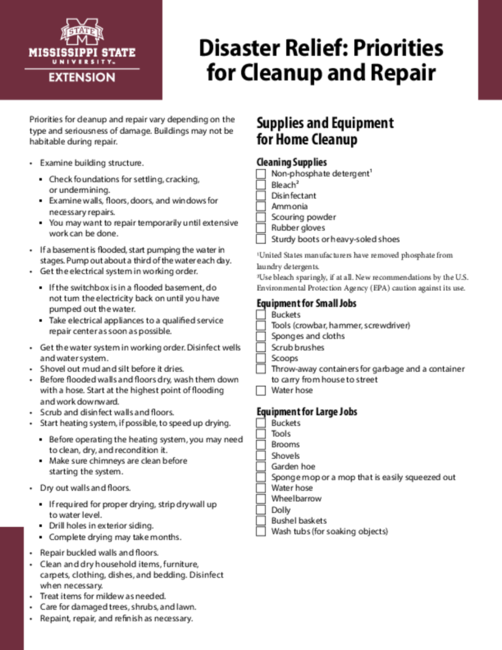P3676
Disaster Relief: Priorities for Cleanup and Repair
Priorities for cleanup and repair vary depending on the type and seriousness of damage. Buildings may not be habitable during repair.
- Examine building structure.
- Check foundations for settling, cracking, or undermining.
- Examine walls, floors, doors, and windows for necessary repairs.
- You may want to repair temporarily until extensive work can be done.
- If a basement is flooded, start pumping the water in stages. Pump out about a third of the water each day.
- Get the electrical system in working order.
- If the switchbox is in a flooded basement, do not turn the electricity back on until you have pumped out the water.
- Take electrical appliances to a qualified service repair center as soon as possible.
- Get the water system in working order. Disinfect wells and water system.
- Shovel out mud and silt before it dries.
- Before flooded walls and floors dry, wash them down with a hose. Start at the highest point of flooding and work downward.
- Scrub and disinfect walls and floors.
- Start heating system, if possible, to speed up drying.
- Before operating the heating system, you may need to clean, dry, and recondition it.
- Make sure chimneys are clean before starting the system.
- Dry out walls and floors.
- If required for proper drying, strip drywall up to water level.
- Drill holes in exterior siding.
- Complete drying may take months.
- Repair buckled walls and floors.
- Clean and dry household items, furniture, carpets, clothing, dishes, and bedding. Disinfect when necessary.
- Treat items for mildew as needed.
- Care for damaged trees, shrubs, and lawn.
- Repaint, repair, and refinish as necessary.
Supplies and Equipment for Home Cleanup
Cleaning Supplies
- Non-phosphate detergent1
- Bleach2
- Disinfectant
- Ammonia
- Scouring powder
- Rubber gloves
- Sturdy boots or heavy-soled shoes
1United States manufacturers have removed phosphate from laundry detergents.
2Use bleach sparingly, if at all. New recommendations by the U.S. Environmental Protection Agency (EPA) caution against its use.
Equipment for Small Jobs
- Buckets
- Tools (crowbar, hammer, screwdriver)
- Sponges and cloths
- Scrub brushes
- Scoops
- Throw-away containers for garbage and a container to carry from house to street
- Water hose
Equipment for Large Jobs
- Buckets
- Tools
- Brooms
- Shovels
- Garden hoe
- Sponge mop or a mop that is easily squeezed out
- Water hose
- Wheelbarrow
- Dolly
- Bushel baskets
- Wash tubs (for soaking objects)
Resources
For more detailed information and illustrations about flood and mold cleanup, visit the following websites, or search by title and sponsoring organization.
- A Field Guide for Flooded Home Cleanup: An illustrated 18-page booklet created through a cooperative effort of the National Center for Healthy Housing, NeighborWorks America, Enterprise Community Partners, and other partners.
- A Brief Guide to Mold, Moisture, and Your Home: Photos and instructions may be viewed online, or a booklet may be downloaded, with EPA recommendations.
- Flood Cleanup and the Air in Your Home: Basic safety and cleanup information from EPA in an easy-to-read booklet with color illustrations. Also available in Spanish.
- Disaster Relief & Recovery Services: Resources provided by the American Red Cross.
- Recover and Rebuild: Resources provided by the Federal Emergency Management Agency (FEMA) resources.
Publication 3676 (POD-10-24)
Reviewed by Rubin Shmulsky, PhD, Professor and Head, Sustainable Bioproducts.
The Mississippi State University Extension Service is working to ensure all web content is accessible to all users. If you need assistance accessing any of our content, please email the webteam or call 662-325-2262.
